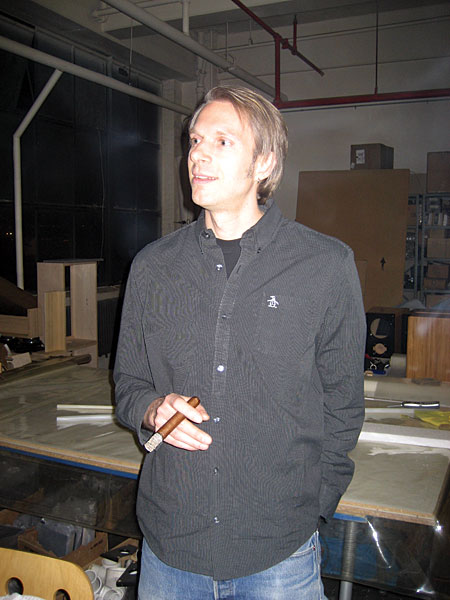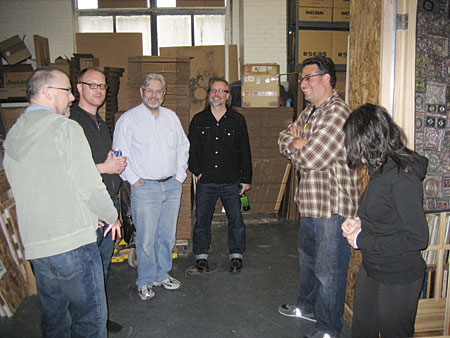| Columns Retired Columns & Blogs |
Listening #92 Page 3
I think the playback system owed at least some of its effectiveness to the room: 25' by 15' of golden-ratio goodness, with an 11' ceiling, decorated with rugs, kilims, original paintings, lots of record and amp storage, and two not-unpleasant old cats. And I know for sure the records owed much of their impact and color to the magnificent system: a pair of DeVore Silverback Reference loudspeakers; a pair of Shindo's new Lafon GM 70 monoblock amplifiers; various Shindo preamps, including a Vosne-Romanee, a Monbrison, and a variable-EQ version of the Aurieges Phono; and a really nice Garrard 401, used in a custom DeVore/Box Furniture plinth with an EMT 997 tonearm and various EMT pickup heads. Through that collection of artisanal gear, the sound wasn't merely hi-fi; as Stephen Mejias said of another Monkeyhaus experience, it was bloody. No better way to put it—and no other way to get it. On a 78rpm disc, one second of music is accounted for by more groove area than any other type of phonograph record; the recordings are all direct-to-disc (at least up the end of the 1940s); and there's less junk between the artist and the listener than in any other format.

Stephen Mejias has written compellingly about Monkeyhausen past in his blog on Stereophile.com, as has Michael Lavorgna; read them both, for a fuller taste of what this hobby has to offer at its best and brightest. And while it's not for me to invite y'all to just drop in on the DeVore factory whenever the fancy strikes, I do recommend taking a spin down Flushing Avenue to the Brooklyn Navy Yard some one of these days, just to see what's what. (If nothing else, fellow fans of the Pendergast novels, by Douglas Preston and Lincoln Child, will see for themselves that there really are such things as abandoned mansions in New York City!)
Not that I was envious or anything . . .
I asked Jonathan Halpern how he finds so many great 78rpm records. As it turns out, more often than not, they find him. Now I've enjoyed the same good luck for myself, thanks to that most wonderful of all God's creations: a generous reader with excellent taste and limited record-storage space.
Noting the shellac-love I expressed in an earlier column, New Yorker Roy Bruce, a longtime employee of New York's Metropolitan Opera and a frequent panelist on their Saturday-afternoon broadcasts, wrote to offer me nearly 200 well-preserved 78rpm records in his possession. So on the morning after Monkeyhaus, I made my way to Bruce's apartment in northern Manhattan to collect my new treasures, and to marvel at the largest, most comprehensive, most intelligently assembled collection of opera on vinyl that I've ever seen.
Knowing my capacity for slobbery gratitude, God cleared for me a fine and unambiguously legal parking space near to Bruce's apartment building. But Oh! shellac is heavy stuff, and the addition of several dozen 78rpm records to the trunk of my Toyota Prius had a noticeable impact on its gas mileage. Nonetheless, they and I made it home all right. And after I'd unpacked and helped make dinner and got Julia off to bed, I decided not to wait another hour before listening to at least some of those titles. So I installed the EMT OFD 65 pickup head that Jonathan Halpern had loaned me for review, with its 78rpm-specific conical stylus and its 9gm downforce, and before I went to bed I listened to Moriz Rosenthal playing a Chopin Mazurka, Op.63 No.3; Benno Moiseiwitsch playing a Rachmaninoff Prelude, Op.32 No.10; and Madame Ernestine Schumann-Heink singing Tchaikovsky's "Nur, wer die sehnsucht kennt." The next morning I listened to the New York Philharmonic playing the overture to Wagner's Flying Dutchman under the direction of the legendary Wilhelm Mengelberg, and a live recording from Bayreuth of the prelude to Act III of Wagner's Parsifal. Conducted by Siegfried Wagner.

Life is good. I know how fortunate I am, not just to have those records but to have a nice collection of playback gear that delivers the kind of body, color, momentum, presence, drama, and sheer singing musicality that I hear in live music—as opposed to the lacey, fussy, airy, and temporally frozen sound that the old-guard gurus and their neurotic lapdogs think we should want.
Sometimes I pause to wonder about the long list of playback gear I've heard throughout the years: to name, just for my own amusement, those things that have so changed the way I think about home audio that I'd never want to be without them. So it was on the Monday after Monkeyhaus, when I realized how much deeper my relationship with music had become, now that I'd heard some of the best recordings in history played back properly. As with the similarly wonderful EMT OFD 25 pickup head, which is designed for mono LPs, the 78-specific EMT OFD 65 has been one of the real keys to my enjoyment. Before that day was through, I'd written a check for it.
- Log in or register to post comments




































